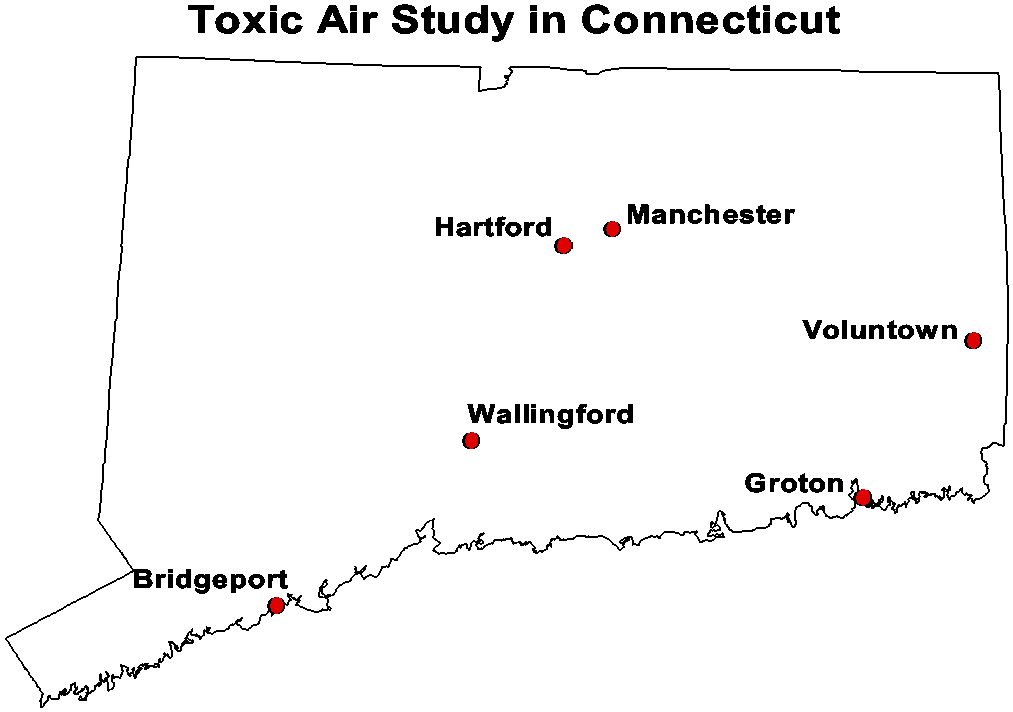Connecticut's Management of Toxic Air Pollutants
The Next Steps for Controlling Air Toxics in Connecticut
Much progress has already been accomplished in the area of controlling air toxics emissions in Connecticut, but there still is more work to complete. The Department has established the air toxics control program as a priority and will focus on several key issues to successfully reduce environmental levels of air toxics. These issues include revision of the state regulation for control of air toxics, expanding the information available on ambient levels of air toxics in Connecticut through monitoring, developing an inventory of air toxics, and continuing to offer outreach programs both to Department staff, the regulated community and the public.
Regulations of Connecticut State Agencies: The Department proposes to revise its regulation for control of air toxics to incorporate new information that has become available since the adoption of the regulation in 1986. The complexity of the existing regulation and the Department's focus on ozone precluded earlier revision. Resources previously committed to other issues can now be directed to revising the regulation. In keeping with the regulatory structure of the existing regulation, the Department requested the Connecticut Department of Public Health propose changes to the existing hazard limiting values contained in the existing regulation. The revised regulation will serve to better protect public health in Connecticut.
1990 Clean Air Act Amendments: A major portion of the Department's focus on air toxics for the future will be continuing planning and implementation of the Title III, Air Toxics Program of the Act. The Department identifies facilities subject to federal Maximum Achievable Control Technology (MACT) requirements and conducts outreach activities to educate the owners and operators of such facilities about regulatory requirements and to assist them with compliance. The compliance efforts will include providing information and conducting workshops as well as providing technical expertise during facility inspections by enforcement staff. MACT rules include not only emission standards, but also work practice requirements, such as monitoring for leaks. Compliance with these regulations will result in reductions of emissions of air toxics. 
Air Toxics Inventory: To enhance the existing emission inventory effort for criteria air pollutants, the Department is planning to compile an air toxics inventory. This new effort will provide summary information on Title V sources and their emissions. It can be used to evaluate emission trends and provide a basis for program development efforts. The 188 hazardous air pollutants identified in the CAAA should be included in the air toxics inventory. Over time, the inventory will be updated and the list of hazardous air pollutants reviewed.
Prevention of Accidental Releases: Facilities using certain chemicals which present a potential hazard to the public should these chemicals be released into the air are subject to the federal accidental release program. In an effort to prevent the accidental release of hazardous chemicals into the air, and to mitigate the effects of releases that might occur, federal regulations require facilities using certain quantities of listed chemicals to study how they safely store and use these chemicals. These facilities also have to coordinate responses to accidental releases with local emergency response organizations, e.g., police and fire departments. Facilities subject to these regulations must submit Risk Management Plans, detailing their hazards, how these hazards will be mitigated, and how the facility will respond to accidental releases, so that the public will be informed.
Risk Assessment: The Department of Public Health, Division of Environmental Epidemiology and Occupational Health conducts risk assessments on air toxics found in Connecticut. These assessments may be specific to a particular emissions source (e.g., industrial stack, incinerator, landfill) or they may evaluate the overall risks in a populated area affected by multiple sources. The Department of Public Health's quantitative risk assessment takes into consideration background air concentrations to determine which chemicals are unique contributors to risk in the area studied, and which can be expected across the state due to factors such as transport from out of state and from automobile emissions. Risk assessment documents are provided to the Department and local health departments. The Department of Public Health is available by phone at 860-509-1367 to respond to public inquiries and to explain risk assessments.
For more information on Connecticut's Management of Toxic Air Pollutants, please contact Ellen Pierce at (860) 424-3027 or ellen.pierce@po.state.ct.us
CT's Management of Toxic Air Pollutants
Content Last updated November 2005

